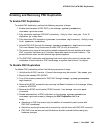
ATM-NTWK (ATM Network Error)
Issue 1 June 2005 585
Possible symptoms include audible artifacts in talk paths and failure of modems over voice
lines. If cell loss is happening generically in the ATM network, other symptoms like
“excessive AAL-5 CRC errors” or “excessive LAP-D retransmissions” are possible on SVCs
with Variable Bit Rate (VBRnt) traffic contracts. The VBR SVCs transport system links such
as EAL, PACL, and PRI links.
Another ATM board within the system originally generated the arriving cells at the specified
traffic contract rate. In order to have arrived at a lower rate, these cells were either slowed
during transmission or possibly discarded by the ATM network. This indicates problems
with cell transmission in the ATM network. Consult the ATM network vendor. Ask about cell
delay variation, cell discard, and traffic policing.
Cell underruns often happen in conjunction with cell overruns. If both occur, it further indicts
the ATM network.
g. Error Type 1537: ATM Cell Overruns
Communication Manager ATM monitors for cell overrun conditions on SVCs with Constant
Bit Rate (CBR) traffic contracts or on ATM CES trunks. In either case, cells are expected to
arrive at a fixed rate. If cells arrive above that rate, an overrun condition exists. The most
likely cause of cell overruns is a problem with cell transmission through the ATM network.
Both cell underruns and overruns are typical symptoms of cell transmission problems like
cell jitter or delay. The ATM board attempts to compensate somewhat by buffering cells.
However, if the ATM network transmission delays are high, the board could conclude that it
has seen a cell overrun because it has exhausted all of its buffer space.
If cell underruns or both cell underruns and overruns occur, indict the ATM network. Consult
the ATM vendor. Ask about cell delay variation, cell discard, and traffic policing.
Another much less likely cause of cell overruns is that an ATM board is generating cells
above the traffic contract rate. Suppose, a board somehow generates cells too quickly. The
ATM network likely reacts by at least setting the CLP bit in the cells that exceed the traffic
contract (see note (d) for ATM CLP errors). The ATM network can also discard the excess
cells.
If only cell overruns occur, locate the ATM board generating those cells. Execute test
board long. If the board passes, then the ATM network remains the likely cause of
transmission problems. Consult the ATM network vendor. Ask about cell delay variation,
cell discard, and traffic policing.
h. Error Type 1793: ATM lost cells:
The ATM board receiving the CBR cell stream is detecting out-of-sequence AAL1 sequence
numbers, above the defined threshold. This normally indicates that the ATM network has
lost the missing cells. In this case, “lost” could mean that the cells were, for example,
policed out, lost to congestion, or misdirected to another endpoint.
The likely user-visible symptoms of lost cells are missing talk paths or poor voice quality.


















